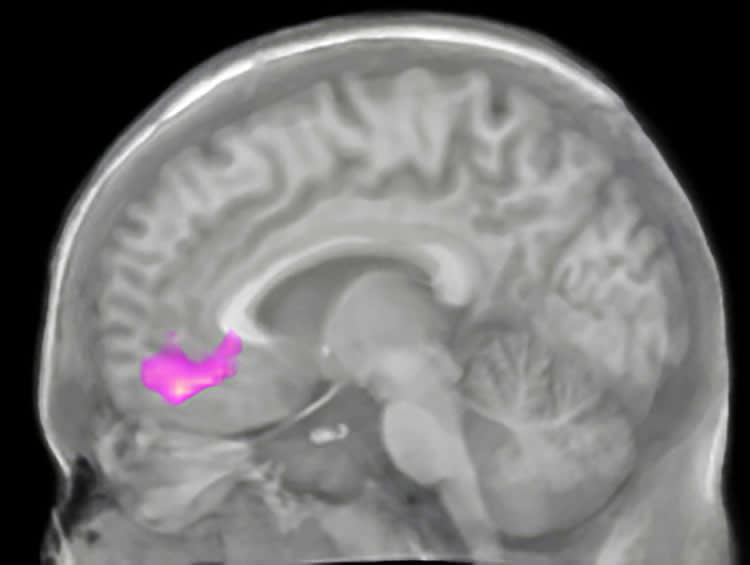Summary: Researchers report a single session of transcranial magnetic stimulation can significantly reduce drug cue reactivity for those with substance abuse problems.
Source: Elsevier.
In a study investigating the use of transcranial magnetic stimulation (TMS) for drug addiction, researchers at Medical University of South Carolina are the first to demonstrate that the noninvasive brain stimulation technique can dampen brain activity in response to drug cues in chronic alcohol users and chronic cocaine users. The findings are published in Biological Psychiatry: Cognitive Neuroscience and Neuroimaging.
Although the last 50 years of clinical and preclinical research have demonstrated that addiction is a brain disease, there are still no neural circuit-based treatments for substance dependence or the brain functions involved in the disorder. “Here, for the first time, we demonstrate that a new non-invasive brain stimulation technique may be the first tool available to fill this critical void in addiction treatment development,” said senior author Colleen Hanlon, PhD.
Elevated brain activity in response to drug cues–referred to as cue reactivity–occurs with many types of drugs, including nicotine, alcohol, marijuana, and cocaine. Cue reactivity also predicts relapse in addiction, so treatment approaches targeting the neural circuitry related to cue reactivity may directly impact cue-induced relapse in patients.
“Therefore, these results have a tremendous potential to impact both basic discovery neuroscience as well as targeted clinical treatment development for substance dependence,” said Dr. Hanlon.
First author of the paper Tonisha Kearney-Ramos, PhD, and colleagues performed two independent studies at the same time, one involving 25 people with cocaine use disorder and the other involving 24 people with alcohol use disorder. The participants received one session of TMS, which targeted magnetic stimulation to circuitry critical for drug-taking behaviors–the ventromedial prefrontal cortex. The real stimulation session was compared against a sham session that mimicked the experience of receiving TMS without actual brain stimulation.
Brain imaging before and after TMS revealed that when alcohol users viewed images of alcohol-related cues, such as a liquor bottle, the single TMS session significantly reduced their drug cue reactivity. The same was true for cocaine users when viewing images of cocaine-related cues.
“Since cue reactivity has previously been associated with abstinence, these studies suggest a common mechanism for treatment effects across disorders, with fMRI serving as a promising neural readout of treatment effects,” said Cameron Carter, MD, Editor of Biological Psychiatry: Cognitive Neuroscience and Neuroimaging.

However, it is still unclear if the changes in brain activity observed in the study will translate to reduced drug or alcohol use. The participants did not report any changes in their drug or alcohol craving after TMS. The authors think that repeated sessions of the targeted stimulation may be needed to see changes in self-reported craving. The researchers hope to answer this question in an ongoing clinical trial involving multiple TMS sessions in cocaine users.
In addition to substance abuse, elevated cue-reactivity is a core symptom of many diseases, such as post-traumatic stress disorder, generalized anxiety disorder, traumatic brain injury, smoking, and obesity, said Dr. Hanlon. “Therefore, the treatment described in this manuscript may have implications far beyond the substance abuse field.”
Source: Rhiannon Bugno – Elsevier
Publisher: Organized by NeuroscienceNews.com.
Image Source: NeuroscienceNews.com image is for illustrative purposes only.
Original Research: Abstract for “Transdiagnostic Effects of Ventromedial Prefrontal Cortex Transcranial Magnetic Stimulation on Cue Reactivity” by Tonisha E. Kearney-Ramos, Logan T. Dowdle, Daniel H. Lench, Oliver J. Mithoefer, William H. Devries, Mark S. George, Raymond F. Anton, and Colleen A. Hanlon in Biological Psychiatry: Cognitive Neuroscience and Neuroimaging. Published April 9 2018.
doi:10.1016/j.bpsc.2018.03.016
[cbtabs][cbtab title=”MLA”]Elsevier “Magnetic Stimulation Dampens Brain Response to Drug Cues in Addiction .” NeuroscienceNews. NeuroscienceNews, 15 May 2018.
<https://neurosciencenews.com/tms-addiction-cues-9055 />.[/cbtab][cbtab title=”APA”]Elsevier (2018, May 15). Magnetic Stimulation Dampens Brain Response to Drug Cues in Addiction . NeuroscienceNews. Retrieved May 15, 2018 from https://neurosciencenews.com/tms-addiction-cues-9055 /[/cbtab][cbtab title=”Chicago”]Elsevier “Magnetic Stimulation Dampens Brain Response to Drug Cues in Addiction .” https://neurosciencenews.com/tms-addiction-cues-9055 / (accessed May 15, 2018).[/cbtab][/cbtabs]
Abstract
Transdiagnostic Effects of Ventromedial Prefrontal Cortex Transcranial Magnetic Stimulation on Cue Reactivity
Background
Elevated frontal and striatal reactivity to drug cues is a transdiagnostic hallmark of substance use disorders. The goal of these experiments was to determine if it is possible to decrease frontal and striatal reactivity to drug cues in both cocaine users and heavy alcohol users through continuous theta burst stimulation (cTBS) to the left ventromedial prefrontal cortex (VMPFC).
Methods
Two single-blinded, within-subject, active sham–controlled experiments were performed wherein neural reactivity to drug/alcohol cues versus neutral cues was evaluated immediately before and after receiving real or sham cTBS (110% resting motor threshold, 3600 pulses, Fp1 location; N = 49: 25 cocaine users [experiment 1], 24 alcohol users [experiment 2]; 196 total functional magnetic resonance imaging scans). Generalized psychophysiological interaction and three-way repeated-measures analysis of variance were used to evaluate cTBS-induced changes in drug cue-associated functional connectivity between the left VMPFC and eight regions of interest: ventral striatum, left and right caudate, left and right putamen, left and right insula, and anterior cingulate cortex.
Results
In both experiments, there was a significant interaction between treatment (real/sham) and time (pre/post). In both experiments, cue-related functional connectivity was significantly attenuated following real cTBS versus sham cTBS. There was no significant interaction with region of interest for either experiment.
Conclusions
This is the first sham-controlled investigation to demonstrate, in two populations, that VMPFC cTBS can attenuate neural reactivity to drug and alcohol cues in frontostriatal circuits. These results provide an empirical foundation for future clinical trials that may evaluate the efficacy, durability, and clinical implications of VMPFC cTBS to treat addictions.






